Minimalist Shoes: Fad or Innovation?
One of the most interesting, latest trends in training and musculoskeletal health is minimalist shoes.
What are minimalist shoes?
Minimalist shoes, also known as barefoot shoes or zero-drop, are designed to closely mimic the feeling of walking or running barefoot while still providing some level of protection and support to the foot. These shoes allow natural movement of the human foot, promoting a healthier and more efficient walking and running experience.
Minimalist shoes are extremely flexible, lightweight and only provide a very thin sole, with minimal cushioning and support. They are also called zero-drop, meaning the height of the sole at the heel is equal to the height of the sole at the toes (as opposed to traditional footwear that generally provides more cushion at the heel). Minimalist shoes typically have a wider toe box (the front part of the shoe, where the toes are) to allow the toes to spread out, mimicking the experience of walking barefoot.
The human foot is an incredible structure, made up of 26 bones, 33 joint and a complexity of muscles, ligaments and tendons. Our feet are designed to support our weight and propel us by recoiling and springing under tension. They can absorb incredible amounts of force while quickly adapting to the underlying terrain, a prime example of the marvelous engineering of the human body.
What are the benefits of minimalist shoes?
Traditional footwear provides cushioning underneath the heel, thus promoting heel-striking (the heel hitting the ground first) while walking or running. Barefoot or minimalist shoes favor forefoot-striking (the ball of the foot hitting the ground first), thus allowing the foot to act as a shock absorber. Research suggests this difference in biomechanics may reduce impact forces on our joints (ankles, knees and hips), thus potentially decreasing the risk of running-related injuries.
Minimalist shoes promote a more natural foot motion, which can help engage and strengthen the muscles of our feet, ankles, and lower legs that may be underutilized when wearing traditional, heavily cushioned shoes. Barefoot shoes typically have a thin and flexible sole, which allows our foot muscles to engage more actively while walking or running. This can lead to improved overall foot strength and stability over time.
The thin sole and lightweight design of barefoot shoes provide a more direct connection between our feet and the ground, ensuring a better proprioceptive feedback from our feet to our balance centers in the brain. By allowing joints, muscles, ligaments and tendons in our feet to move in response to changes in terrain, our body can adapt more effectively, improving balance and body awareness while running, walking or hiking. This heightened awareness can improve stability and reduce the risk of falls and injuries.
Research suggests that barefoot shoes can improve running efficiency due to their lighter weight and changes in running form and efficiency. By encouraging forefoot-striking, runners may be able to effortlessly use the spring-like mechanism our feet were designed to take advantage of, thus conserving energy and potentially enhancing performance.
Despite these benefits, it's essential to note that transitioning to minimalist shoes should be done gradually, especially if you've been wearing traditional shoes with significant cushioning and support. Abruptly switching to minimalist shoes can put additional stress on your feet and increase the risk of injury. If you're considering transitioning to minimalist shoes, it's a good idea to consult with an healthcare practitioner or running expert to ensure it's the right choice for your foot health and activity level.



